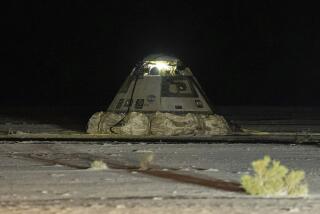Trauma, Guilt Persist for Space Workers
KENNEDY SPACE CENTER, Fla. — The clock at Mission Control was set to stop at six days, zero hours and 34 minutes. That’s when Challenger and its seven crew members were supposed to come home.
Three days after the launching, it was still ticking, T-plus 74 hours into a mission that had lasted 73 seconds. “It gave me the creeps,” one space center employee said. “I kept hoping somebody would shut it off.”
Mission May Never End
Finally, somebody did. But, in very personal ways for many of Kennedy Space Center’s 15,000 employees, the Jan. 28 Challenger mission may never end.
“There’s a piece of me that went down with that thing,” said George Hinton, an employee of Morton Thiokol Inc., maker of the shuttle’s solid rocket boosters.
In a program that asks every technician, engineer, crane operator and mechanic to personally identify with the effort to transport Americans into space, the worry, the heartache--even the guilt--of the shuttle accident won’t go away.
“I feel like I had a hand in killing seven people,” computer engineer Richard Prickett said.
“I still see it (the explosion) at odd moments,” software analyst Carol Miller said. “I won’t be thinking about it, and then I’ll close my eyes . . . .”
“Many of the employees are feeling quite anxious--’Gee, am I at fault?’--and depressed. But the whole community has a feeling of loss and mourning,” Satellite Beach psychologist Suzanne Sobel said.
Although the entire country has deeply mourned the loss of Challenger’s crew, she said, “there isn’t the kind of personalization we have here.”
‘Psychological Disaster’
For many of the workers in the shuttle program, the fiery accident was nothing short of “a psychological disaster,” Sobel said.
The first known on-the-ground casualty was Elmer Thomas, a 69-year-old engineer who collapsed with a heart attack shortly after the accident in a launch viewing room here and died two days later.
The next day, a Lockheed employee “almost lost his mind” after watching a news report about the explosion and its aftermath, a friend recalled.
The news program had focused on an accident the night before the launching when Challenger’s huge external fuel tank was slightly scratched while a service platform was being removed.
The Lockheed employee had been on the work crew in question that night.
And, even though the scratch apparently was repaired, and space center directors determined that it had posed no threat to the safety of the shuttle, the worker reacted strongly to the news account.
‘I’ve Killed Seven People’
“This is it, it’s my fault. I’ve killed seven people,” the worker’s friend quoted him as saying. “He told me it (a crane) barely touched it (the fuel tank), but he says, ‘My God, what if I did do something?’ ”
Some workers have found a certain relief in recent days as the investigations into the accident appear to be zeroing in on managers of both NASA and Morton Thiokol who made the decision to launch against the recommendations of engineers who advised postponement because of the cold weather.
“It wasn’t something we did,” said one worker.
Still, a sense of bitterness lingers.
Said a Honeywell engineer, who asked not to be identified: “I’ve been working for the space program since 1972. We live this thing day in and day out. And, to think somebody on the team would make a decision that would jeopardize those lives and our livelihood . . . just hurts the hell out of me.”
After the Challenger accident, NASA set up a hot line for employees.
So far, a little more than 100 have called. Many report having nightmares; some weep into the telephone; others say they feel too ill to go to work. The “severe cases” are referred to counselors or psychiatrists. One caller complained that her family simply could not relate to how she felt about it.
As the shock of the accident has dulled, the fear of layoffs is increasingly spreading through Florida’s space center, where a quarter of the work force holds jobs linked to the space program.
Employees Laid Off
Just two days after the accident, Ivy Speel Erectors said that it was laying off 60 employees who work on the shuttle’s launching platform. Lockheed, the prime contractor on processing the shuttle for launching, announced that it was terminating 30 temporary jobs. ITT Telecom and Pan American World Services let more than 360 people go.
More to Read
Sign up for Essential California
The most important California stories and recommendations in your inbox every morning.
You may occasionally receive promotional content from the Los Angeles Times.










